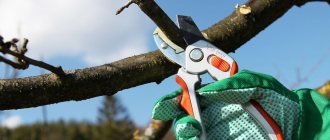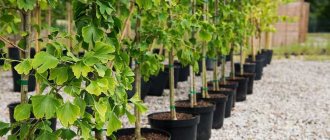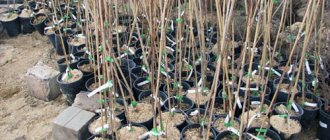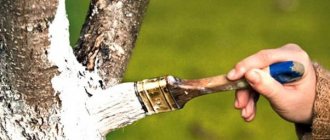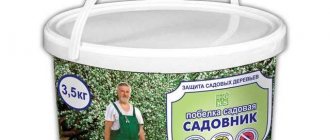Every farmer dreams of having a miracle tree in his garden, on which two different varieties of apple or pear trees will grow simultaneously. To get such an amazing exhibit, it is important to figure out when is the best time to graft fruit trees. As practice shows, this can be done in spring, summer or autumn. However, there are certain caveats to consider.
How and when to graft fruit trees
Fruit crops can be grafted throughout the year, but the spring procedure is considered the most effective. The optimal time for carrying out manipulations is from the first half of March to June. The air temperature during the day should be at least 10°C, and at night – 0°C. An important rule is that sap flow starts in the rootstock (the place where the grafting is planned). The scion (a specimen that takes root on a tree) is used only in a dormant state. Having determined the timing of spring grafting of fruit trees, you should begin the preparatory process - choosing a rootstock and preparing scions.
The rootstock should be winter-hardy and compatible with the scion.
Often, for grafting pear or apple trees, “wild ones” are used, which have a powerful root system and good adaptability to new growing conditions.
It is better to harvest cuttings (scions) in the autumn. If the climate in your region is not harsh, then you can perform this process in the spring, but before the buds swell. It is not recommended to use scions that are too young; they do not take root well. If the cuttings will be stored for a long time, be sure to treat them with a garden varnish.
Grafting fruit trees: choosing tools
To complete the process of creating new varieties, you will need to prepare gardening tools:
A set of necessary tools for grafting garden trees
- grafting pruners;
- copulating knives;
- garden hacksaws to trim thick branches;
- flat screwdriver;
- garden varnish to treat affected areas;
- electrical tape to secure the treated part.
Remember that before carrying out the procedure, you must disinfect the pruning shears for grafting fruit trees, as well as other tools.
Rootstock requirements
The rootstock is the basis for grafting. It is the rootstock that will subsequently feed the grafted tree; how winter-hardy and disease-resistant the plant will be depends on the rootstock. Rootstocks can be cultivated or wild, low-growing or vigorous. They are obtained by vegetative or generative propagation.
- Pruning strawberries: how, when and why
Before choosing a rootstock, you must know exactly what goal you are pursuing so that your expectations are likely to be met. It is desirable that the rootstock has such qualities as cold resistance, drought resistance, has well-developed roots and is adapted to your area.
Important conditions for the procedure for grafting garden trees
When creating new varieties of fruit crops, several important recommendations should be taken into account:
- It is allowed to graft 2-3 varieties onto one crop. The main thing is that the timing of fruit ripening coincides.
- Do not touch with your hands the places where the scion and rootstock are connected.
- The procedure is performed as quickly as possible so that the cut and incision sites are not exposed to ultraviolet rays for a long time.
Also, be sure to ensure that the cambial layers of the rootstocks and scions are tightly fixed to each other.
Introduction to Basic Concepts
First, you should familiarize yourself with the basic concepts that will be used when we talk about vaccination technology:
- Rootstock. This is the name of the plant on which we will graft a new variety. As a rule, the grafting is done in the lower part of the plant. This can be a trunk (bole) or a root.
- Scion. This is the part of the varietal plant that will be grafted onto the rootstock. The scion will form the upper part of the plant, which is responsible for its varietal characteristics.
The rootstock and scion must match each other. Otherwise, engraftment may not occur. Plants that are botanically related are usually selected. You cannot graft a pear onto a birch tree. A forest pear or quince is suitable for it if you plan to create a dwarf variety. However, pears with apples growing on separate branches are very common.
This plant compatibility table will help you quickly figure out which rootstock plants can be grafted with scion plants
Effective methods of grafting fruit trees
There are several methods for how to properly graft fruit trees. Let's look at them in more detail.
Methods of grafting garden trees
Copulation
This method of obtaining new varieties is relevant for apple trees, pears, and stone fruits.
Cherry grafting using copulation method
Rootstocks should have a diameter of no more than 15 mm; cuttings should be of the same size. Copying is carried out as follows:
- On both parts that will be connected, make 1 cut of identical size so that the angle is 25-30°C. An oblong incision (tongue) is made in the middle of the sections; its length is 10 mm.
- The rootstock is connected to the cuttings so that the tongues are fastened, and the thin layers of green color (cambial) coincide.
- The treated area must be wrapped with electrical tape (placing the sticky layer on the outside).
Fresh cuttings are fixed with cling film or polyethylene.
Vaccination for bark
The method is suitable for adult crops that are more than 3 years old; it is also used for thick rootstocks.
Method of grafting garden trees by bark
This is the best option for how to properly plant a pear in the spring and other pome crops. The rootstock is taken with a diameter of 20-190 mm, the scion – no more than 15 mm. Execution algorithm:
- The rootstock is cut at a height of 1000 mm, possibly 300 mm from the trunk. The cut is cleaned using a knife treated with alcohol, but do not touch the wood with your limbs. Otherwise, an infection will occur.
- The scion needs a smooth oblique cut from below (length about 40 mm).
- An oblong cut is made on the rootstock (length - 40 mm), then the bark is lifted.
- The cutting is fixed into the resulting “pocket” so that 0.2 cm of the cut protrudes above the cut site.
At the end of the manipulations, the open areas are treated with a special protective composition (garden pitch is suitable), after which the place where the grafting was made is covered with electrical tape.
Grafting of fruit trees into clefts
Splitting is characterized by speed; the method is used before the start of sap flow and awakening of the kidneys.
The rootstock is taken with a diameter of up to 7 mm, the cutting – no more than 15 mm. The process is carried out according to the scheme:
- Cut the rootstock (height - 250 mm) from the ground/trunk. A split is created in the center of the cut, the depth of which is up to 50 mm, and a wedge is inserted there.
- Cuttings with buds are used; 2 wedge-shaped cuts (30-40 mm long) are made on each specimen.
- The cuttings are placed in a split so that the cambium of the two crops is united.
At the end, a wedge is pulled out of the split, the area is covered with electrical tape, and treated with garden varnish. The cutting takes root within 2 weeks, after which the buds swell on it.
Mastery of garden surgery: copulation and budding
Regardless of what timeframe the farmer chooses for grafting fruit trees, he needs to carry out the event itself correctly.
In gardening, there are 3 methods of grafting crops:
- Simple copying. The scion and rootstock are cut at an acute angle. The thickness of each of these branches should be the same.
- Improved copulation. A long section of each cutting is visually divided into 3 parts. Then a longitudinal cut is made from the edge to a depth of 10-12 mm. The resulting parts are connected according to the principle of puzzles.
- Budding. One bud/eye in the shape of a boat (2-3 cm long) is cut out from the mother tree. An incision is made into the bark in the shape of the letter “T” on the rootstock. The graft is inserted into the resulting “pocket” and closed.
After such a surgical operation, you need to connect the scion and rootstock as tightly as possible. To prevent them from falling apart, the grafting site must be tightly bandaged. You can use electrical tape or a strip from a plastic bag. It is recommended to twist it at each turn made.
All open sections of the plant should be lubricated with garden varnish. This will help protect the crop from many diseases.
There is also a simpler way to graft trees - into a split. To do this, you need to cut down the stump at a right angle and make a transverse cut in the middle. It is necessary to insert a wedge into it in order to freely insert stripped branches with 5 buds into the hole. Then the latch is pulled out and the barrel is tied. The cut is treated with garden varnish.
The gardener's usual observation skills will help you learn more about when it is best to plant fruit trees. To do this, you need to carefully monitor how the scion feels, because each variety of culture has its own characteristics. Moreover, the climatic conditions in each area are also different.
Choosing a method and period according to the type of tree
The most frequently asked question among gardeners is when and how to properly plant an apple tree in the spring. It is recommended to postpone the procedure until March-April (as soon as sap flow starts). The optimal solution is to use the split method.
Apricot and peach grafting occurs at the end of April, the first half of May. Performed in a split or behind the bark. If the air temperature is not consistently warm, you need to insulate the place where the manipulations were carried out with film.
Grafting of grapes is usually done by copulation. The optimal period is the end of April, when the air temperature rises to +15°C.
Cherry grafting in spring is carried out during active sap flow. All methods are suitable. Also, all methods are used for cherries and plums.
Compatibility of rootstock and scion
For grafting to be successful, the scion and rootstock must be related. For example:
- Chokeberry, pear and rowan can be grafted onto chokeberry;
- to hawthorn - hawthorn, rowan, cotoneaster, apple and pear;
- for irga - rowan, pear and irga;
- for rowan - chokeberry, rowan, pear and cotoneaster;
- for cotoneaster - cotoneaster, apple and pear;
- for the apple tree - chokeberry, apple tree, pear and cotoneaster;
- to the pear - hawthorn and pear.
In the photo: Pear grafted onto rowan
Almost all stone fruits are successfully grafted onto cherry plum or wild plum seedlings, and cherries and sweet cherries - onto wild cherries or wild bird cherry antipka. The best rootstocks for apple trees are seedlings of the varieties Antonovka, Anis, Kitayka or plum-leaved apple tree. Varietal pears are grafted onto winter-hardy seedlings of pear varieties Vishnevka, Limonka, Tonkovetka or Aleksandrovka. For plums, in addition to cherry plums, thorn and damson seedlings are suitable as rootstocks.
For apricots, rootstocks can be seedlings of zherdelo, sand cherry and sloe, but apricots themselves as rootstocks for other stone fruits are not very reliable: even the peach, related to apricot, is best planted on plum, sloe, almond or felt cherry.
The grafting of a varietal apple tree cutting onto an apple tree or a pear cutting onto a pear wild is called intraspecific, the grafting of a cherry cutting onto a sweet cherry or a peach scion onto an apricot is interspecific, and the grafting of a plum cutting onto an apricot or a pear scion onto a hawthorn is called intergeneric grafting.
Intraspecific vaccinations are most successful, while intergeneric vaccinations often cause complications. But this does not mean that you need to abandon experiments, because there have been cases when currants were successfully grafted onto an apple tree, and apples and berries ripened on the tree at the same time.
Benefits of vaccinations in summer
At first I wanted to cut the cuttings and put them in the refrigerator for spring grafting. But when I started looking for information about preserving the scion, I realized how convenient it is to do budding in the summer.
Firstly, you don’t need to think about saving cuttings. They are stored:
- At home, in the refrigerator, constantly monitoring the humidity. If the temperature is high, rotting is possible; if the temperature is low, the core will dry out and the channels will become clogged. Such a scion will be of no use, and the space in the refrigerator will be reduced.
- In the garden plot, in the snow. But then you need to protect the cuttings from rodents. They are placed in a tin container, a piece of pipe, or wrapped in barbed wire. It is important to find a suitable place for the scions, where there is a lot of snow. This is usually the leeward side of the house or building.
To be honest, I didn’t want to get involved with the cuttings. I decided to do summer vaccination.
Summer is the period of bark growth; the apple tree quickly adapts to cuts. There will be no active gum production at the graft site.
Another plus is that one-year-old shoots are suitable for cuttings; the distance between the buds is small, the bark is easily separated from the core, and the wood is already dense. For spring grafting, one would have to look for two-year-old shoots with growth buds.
The last and most important advantage of summer vaccinations is that the result is immediately visible. By autumn, new branches and leaves appear on the grafted shoot. The following year, full-fledged fruits are formed.
Methods for grafting apple trees in spring
There are several common methods.
Butt copulation
Copying into the butt is common and its variation, which is even more common, is an improved copulation into the butt, with a tongue. Without a tongue, it is more difficult to combine the rootstock with the scion. And if you use a tongue, then combining the rootstock with the scion is easy.
| Note. This does not mean at all that the method of grafting an apple tree in the spring with a tongue is for beginners, and without a tongue is for professionals. Often it is professionals who vaccinate literally with their eyes closed who use this method. |
Copulation into cleft
This method is used in the case when the rootstock (this is what the cutting is grafted onto, say, the crown of a tree) is many times larger than the scion and it is not possible to combine them properly.
The method can be used, for example, when a tree is broken by the wind and you want to restore the lost variety. Or when you have an overgrown rootstock and you can graft another variety onto it. You use the rootstock, and you won’t need to uproot it and throw it away. On the site you will soon receive a nice tree, created literally with your own hands.
Photo: The procedure helps save trees.
Side cut
Used when the rootstock is much thicker than the scion. Usually it is incomparably thicker; for example, a cutting can be literally grafted into a tree trunk. In this case, you can graft another variety into the crown of the tree so that there is a pollinator in the crown. There will be no need to plant a second tree on the site in order to obtain stable and full-fledged harvests.
Thanks to this method, even a fairly thin cutting can be grafted into the crown of a fairly mature tree. You can get a fairly powerful branch from a thin cutting in the crown, which will bloom in the future and pollinate your entire tree.
The younger the better
Of course, in this case it is necessary to re-vaccinate. It's never too late to uproot. Newly planted trees will begin to bear fruit in 5-6 years, and with regrafting, a new harvest can be obtained after 2-3 years. The only condition is that the tree must be healthy: without frost damage and sunburn on the trunk or in the forks of skeletal branches, with a trunk not damaged by mice and hares. It is important not to delay the decision: the younger the plant, the better the result. As a rule, trees no older than 10 years are regrafted.
Grafting young seedlings with buds
It is more convenient to plant buds on young seedlings under the age of 2–3 years, 0.8–1.3 cm thick. However, in gardens there are often overgrown seedlings that need budding. At the same time, it is taken into account that in perennial apple and pear trees the bark at the base of the trunk has already become coarsened and budding here is rarely possible.
Typically, four to five year old seedlings and root shoots have already formed a trunk, a central trunk and the main skeletal branches. Such plants should not be cut out, as they are excellent rootstock material.
Here, budding works better on skeletal branches and in the upper parts of the central trunk, where there are young growths with uncoarsened bark. The time and technique for budding overgrown trees are the same as for grafting young seedlings.
However, it is taken into account that in the first year of growth, young occulants are not firmly attached to the rootstock, and the strength of their growth on the tree depends entirely on the location in the crown and the direction of the young shoots. The more vertically upward the occulants on a tree are directed, the more intensely they grow.
If budding is carried out from the lower or lateral sides of skeletal branches, then the shoots easily break off at the base, even from their own weight. Branches directed horizontally or downward grow weakly, but lay flower buds faster. Therefore, when budding, the buds are placed at the base of the skeletal branches on the upper side at a distance of 5–20 cm from the central trunk.
What determines the success of vaccination?
Gardeners often ask what determines the survival rate of vaccinations. Success depends on several factors. The first one is a quality tool. The pruning shears must be sharp and clean and not damage the bark of the cut branch (rootstock) or cuttings (scion).
The grafting knife must be made of high-quality steel that holds an edge well. To ensure an even cut, the thickness of the grafting knife blade must be at least 1.5 mm so that it does not bend during the cut. But for ease of use - no thicker than 2.5 mm.
Grafting knives are of two types: copulating (with a straight blade and a wide front part of the blade - a) and budding (the blade is curved and the tip is pointed - b).
The copulating knife is sharpened only on one side, the opposite side of the blade remains flat (c). The sharpness of the knife should be comparable to that of a straight razor. The surface of the blade should be well polished. The blade of a budding knife can be sharpened to a cone (d), but the sharpness of the blade must also be ideal and the surface polished.
All these requirements are necessary to ensure that the cut on the parts joined during grafting is even and smooth. If you use a poorly sharpened knife, the conductive channels of the wood will be partially jammed and will not be accessible for nutrients to penetrate through them. As a result, the scion, having used up its own resources, will wither away.
Preparation of cuttings for spring and summer grafting
For spring grafting, cuttings of cherries, cherries, plums, pears and cherry plums are harvested in late autumn or early winter. This is done because the annual growth of these trees may be damaged by winter frosts. Apple tree cuttings can be harvested throughout the winter, but less winter-hardy varieties should be cut before the onset of severe frosts, during the period of mass pruning of fruit trees.
Cuttings for grafting must be healthy, without signs of damage by pests or diseases, have at least 6 buds, a length of at least 40 cm and a lower cut thickness of 7 mm. The grafting material is prepared with a reserve - 2-3 cuttings per rootstock.
The scions are tied into bundles, signed if necessary and stored in storage at a temperature of 0...+1°C and air humidity of 94-96%. Also, cuttings can be stored under a thick layer of snow, strewn with a 20-centimeter layer of sawdust.
For summer budding, annual branches with slight woodiness and a crunching sound when bent are cut off. The length of the shoot should be at least 30 cm, and the diameter of the lower part should be 5-6 mm. The scions are cut with pruning shears in the morning on the day of vaccination. When cutting, you need to leave 3-4 buds on the tree.
The branches are transferred to the shade and there the leaves are removed from them, leaving petioles up to 1 cm long. The cuttings are delivered to the budding site in a damp burlap. For grafting, healthy buds are used, which are located in the middle of the cutting. During grafting, cuttings that have not yet been used are stored in a bucket of water with a layer of 3-5 cm, covered with a damp cloth.
When can fruit trees be grafted: optimal timing
Fertilizing fruit trees and shrubs in spring and fertilizing the soil
Experienced agronomists recommend grafting in the warm season, when the likelihood of frost at night and in the morning is excluded. The cuttings take root faster, and the wounds from the cut heal faster. It is best to graft trees in spring and summer. There are no strictly defined deadlines, because a lot depends on the weather conditions of the crop’s growth.
Note! Some agronomists also recommend following the lunar calendar, which indicates the most favorable dates and days for the procedure.
Watering cuttings with warm water
Abundant watering of the rootstock with warm water 2–3 days before grafting has a beneficial effect on the survival rate of grafted cuttings. Watering is especially effective in dry and hot weather. In windy weather, the grafted cuttings take root better under a cap made of synthetic film.
At the same time, the evaporation of water from the cutting is reduced, and if the cap is moistened from the inside with clean water before use, then increased air humidity is created. However, if the cap rests directly on the grafted branches in windy weather, it can damage the cutting, so wire protective arcs are placed near the cutting, the ends of which are tightly secured to the rootstock with twine.
In this case, the cap is placed on the protective arches and damage is eliminated. In all cases, the cap from below is tightly tied to the rootstock with twine. After 10–15 days, the cap is removed and the safety bars are left in place.
How long does it take for grafting to take root on fruit trees?
In order for a cutting to take root on a fruit tree, there must be sap exchange between them. That is why grafting is recommended during periods of the most active movement of juice. Such processes actively occur in spring and early summer.
Under favorable weather and climatic conditions, as well as the procedure being performed correctly, the buds on the scion begin to swell after several weeks. This confirms that the merger process is proceeding as expected.
Thus, there is nothing complicated in the process of grafting trees. The main thing is to choose one of the methods described above and strictly follow the instructions.
The benefits of vaccinations
Zoned cherries, apple trees, pears, and plums are grafted onto frost-resistant wildflowers in nurseries. Sometimes grafting is done to speed up the ripening of fruits: if late autumn varieties are grafted onto early ripening varieties, a harvest can be obtained by the beginning of autumn. I know people who have grafted shoots from tall varieties onto dwarf trees.
My neighbor in the garden has a unique apple tree: more than 10 varieties are grafted onto it. I won’t dare to do such an experiment. I started budding to preserve my favorite variety of apples. They are tasty, juicy, and store well.
Why graft an apple tree?
Grafting apple tree cuttings in the spring allows you to get new plants or preserve one or another valuable variety on your site. Or graft a variety into the crown and get a pollinator without planting another plant on the site. These are the main purposes of vaccination. Every gardener must master this process.
- Without going to a nursery, you can get your own planting material and plant any varieties of apple trees on your plot without spending a lot of money.
- You can save this or that variety, for example, when a friend or neighbor gave you a cutting cut from a variety you liked.
- This way you can significantly save space on your site. There are two ways to do this. For example, if you want to have several varieties on one plot, then you do not have to plant several trees of different varieties of apple trees on the plot. You can graft two or three completely different varieties into the crown of an apple tree and harvest.
- It will no longer be necessary to plant a tree of a pollinating variety on the site. You can graft a cutting of another apple tree variety directly into the crown. When a full-fledged branch develops from the cutting and blooms, it will pollinate the entire tree. With just one tree on your plot, you will have a good harvest.
In such a simple way as vaccination, you can surprise your neighbors, please your acquaintances, your family and friends. After all, a tree can simultaneously contain several fruits of completely different colors and tastes, sizes and even ripening periods.
